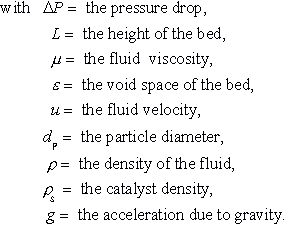







To better understand fluidization of a particle bed, it is necessary to determine what range of flow rates allow fluidization, and also, what flow rates will begin to carry the particles out the top of the particle chamber. We wish to determine a minimum flow rate allowing the particles to become fluidized, the minimum fluidization velocity (um), and the flow rate which carries the first particle out of the chamber, the terminal velocity (ut).
We used the Ergun equation on the packed bed page to describe the drag exerted on a particle bed by the fluid flow. By setting this equation equal to the gravitational force of the particle bed, we can determine the minimum fluidization velocity (um). In this case, the equation is rearranged:


The above equation is a quadratic in u, where u now stands for um, the minimum fluidization velocity.
The ut is the velocity that is large enough to lift a single particle and carry it out of the fluidized bed. Then the equations are those for drag past a sphere. There are three equations for the drag coefficient corresponding to the three flow regimes:
This implies there are three different equations for ut corresponding to these flow regimes. The image below contains the ut equations for the three flow regimes.

